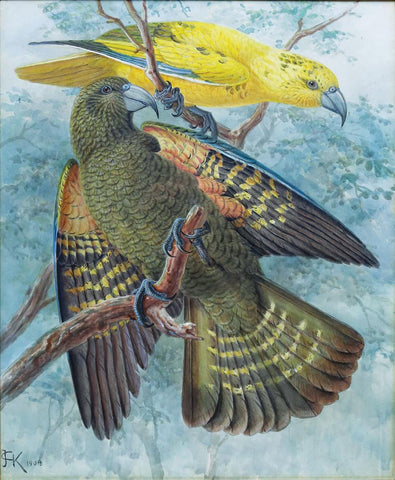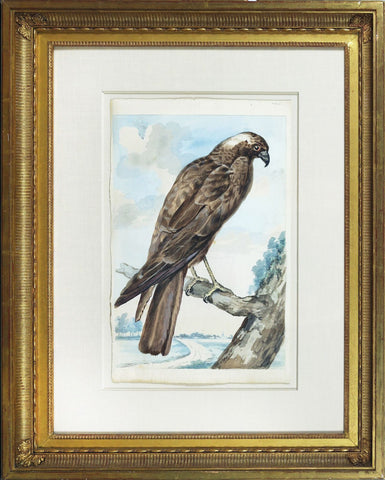
Johannes Gerardus Keulemans (Dutch, 1842-1912), A Wildtype and Golden Kea Perching on a Branch
Johannes Gerardus Keulemans (Dutch, 1842-1912)
A Wildtype and Golden Kea Perching on a Branch
Very likely intended as illustration For Walter Lawry Buller, Supplement to The birds of New Zealand, London (1905), vol 2
Watercolor on paper
Signed lower left: JG Keulemans
1904
Paper size: 16 1/2 x 21 in
Frame size: 27 x 22 in
The kea (Nestor notabilis, Gould, 1856) is the world’s only omnivorous and alpine parrot, endemic to the South Island of New Zealand. Kea are known for their great intelligence and curiosity, both vital to their survival in a harsh mountain environment; they are even capable of preparing and using tools. While their scientific name is given by John Gould in 1856, their common name “kea” derives from Māori and is most likely an onomatopoeic representation of the bird’s in-flight call.
When farmers moved to higher ground in the mid-1860s, their sheep began to suffer unusual wounds on their backs. The cause turned out to be kea using their powerful, curved beaks and claws to rip through the layer of wool and eat the fat from the back of the animal. In order to stop the kea preying on livestock, the New Zealand government paid a bounty for kea bills and in the following hundred years more than 150,000 were killed, until the bounty was lifted in 1970. By then, however, the damage had already been done and the kea population was left to only 5,000 birds, consequently receiving full protection. Nowadays, the parrot is still considered endangered due to treats of introduced predators, lead poisoning, and pesticides. The birds’ naturally trusting behavior towards humans has made them a popular tourist attraction, although their cheekiness and mischievousness also results in trouble-making behavior, such as the chewing of rubber from cars.
Even though Keulemans illustration for A history of the birds of New Zealand shows the notorious reputation of the kea (two birds attack a sheep in the background, ill. 1), Keulemans made a remarkable, elegant, and lively watercolor of this parrot species in 1904. Both kea stare directly into the beholders eye, the one in the back slightly lowering its head as if it were listening, creating an intimate dialogue with the viewer. We strongly believe this watercolor was intended for Buller’s Supplement to the ‘The birds of New Zealand’. First of all, the watercolor is made one year before the publication of the book. Secondly, this edition lacks a depiction of a kea. And last, this work of art has many similarities with Keulemans watercolor of kaka, that also shows a variety of the parrot species, which Keulemans made in the same year and is depicted in the Supplement to the ‘The birds of New Zealand’ (ill. 2). By positioning the birds from a lower angle and depicting the front one with slightly stretched wings and a spread tail, Keulemans was able to feature the bright orange and yellow feathers on the undersides of its wings, which would not have been seen otherwise. These vivacious colors starkly contrast the duller brown and olive green of the rest of its plumage. These kea are life-sized mature birds of at least four years old, as their nostrils and cere have a greyish color. The second parrot has an unusually bright yellow pigmentation. This mutation is known as xanthochromism, hence the name ‘golden’ kea. This golden specimen belonged to Bullers son, as we can read in the description of the kea:
“About seventeen years ago a beautiful yellow Kea was obtained in the Wanaka country in the far South. At that time there was a Government bonus of two shillings a head for Keas, as the bird had been proving very destructive to the sheep. Every man on the station, as a rule, carried with him a fowling-piece on his rounds and came home at night with a bagful of beaks, thus adding not inconsiderably to his weekly wages. Thousands of pounds were paid in the course of the year, by way of bonus, in the Wanaka district alone. (…) In consequence of this persistent slaughter they rapidly grew scarcer, till at length there were so few to be seen that the men at work on the run would not encumber themselves with a gun. When, however, the killing fever was at its height, one of the men, on delivering his tale of beaks, said: “I shot to-day the queerest Kea I ever saw— all yellow!” He added that there was another similar one which he could not get. Finding that the man, after cutting off the beak, had thrown the body aside, the manager sent out to search for the bird, but was unsuccessful, some vagrant dog or hawk having carried it away. In a short time, however, the other was shot and was carefully preserved by the manager, who sent it to Mr. C. Turnbull, of Dunedin. This beautiful specimen has since come into my son’s possession. The whole of the body-plumage is vivid canary-yellow, deepening on the neck, sides of the body and rump into a rich orange-yellow; most of the scapulars and the quills are of the normal colour, except the first primary in each wing which is yellowish-white; tail-feathers canary yellow, excepting two of the outer lateral ones, which are partly normal; lining of wings delicate orange. Here and there, especially on the head, there is a feather or two of the normal colour.”
In the nineteenth and twentieth century golden kea were rare, but due to the killing and higher prices for these specimen, these mutations are even more exclusive. Nowadays only one golden kea in the wild exists.
JOHN GERRARD KEULEMANS (DUTCH, 1842-1912)
One of the foremost ornithological illustrators of the nineteenth-century, John Gerrard Keulemans, has received less recognition than is his due simply because he rarely published his own books, but rather contributed to a number of the most notable bird books of the time. Dutch by origin, he was one of a select band of continental European bird and animal artists to be attracted to England during the middle and latter half of the nineteenth century. Throughout his acclaimed career, his distinctive and exquisitely rendered bird illustrations graced publications including Daniel Giraud Elliot's monographs on the pheasants and hornbills, Henry Eeles Dresser's History of the Birds of Europe, Bowdler Sharpe's monograph on kingfishers, and George E. Shelley's on sunbirds, as well as his own Natural History of the Cage Birds. Keulemans executed and lithographed more than one hundred plates for the British Museum Catalogue of Birds, attesting to his extraordinary diversity and ability to depict birds of widely different species from parrots to birds of prey. His illustrations of birds for works related to geographic regions are equally diverse, covering Great Britain, Europe, Abyssinia, Australia, New Zealand, India, South Africa, and Central America.
Born in Rotterdam in 1842, Keulemans worked for several years at the Leyden Museum. Like his fellow artist Josef Wolf, he was encouraged by the influential Professor Hermann Schlegel, who gave him several important commissions. Like other protegés of Professor Schlegel, he was soon lured away by London's outstanding opportunities, which was then the center for ornithological publications. John Gould had provided the first commissions for Wolf in London, and it was Gould's friend Richard Bowdler Sharpe was responsible for luring Keulemans to England in 1869. By the turn of the century, any author of a bird-book requiring an illustrator almost automatically thought first of Keulemans. Although many of the publications that Keulemans contributed to were ostensibly documentary, his magnificent illustrations inevitably transcended mere science, distinguished by their glorious color and sophisticated compositions.
Keulemans's original work is scarce, and only in his watercolors can one attain a full understanding of his mastery as an ornithological artist. Some Keulemans' original watercolors are in the collection of the British Museum or other institutions, and few become available to private collectors. This magnificent watercolor represents a valuable and unusual opportunity to attain an original work by one of the foremost bird artists working in Victorian Britain.
or by email at loricohen@aradergalleries.
We Also Recommend





